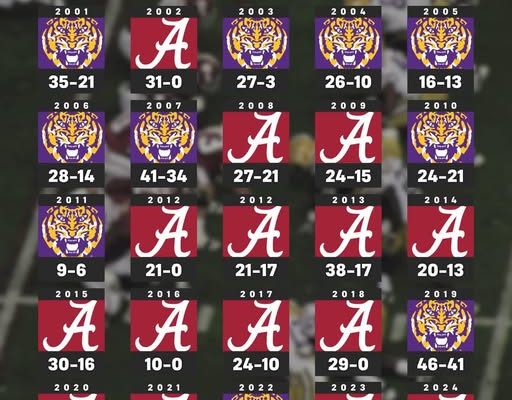The Alabama–LSU rivalry has long been one of the defining matchups in college football, not just in the Southeastern Conference but nationally. Few contests carry the weight, intensity, and history that accompany these two titans whenever they meet on the gridiron. For fans of both programs, this game is more than a contest; it is a showcase of legacy, pride, and the constant battle for supremacy in one of college football’s most competitive landscapes. Over the last 25 meetings between Alabama and LSU, the pendulum of dominance has swung dramatically, reflecting changes in coaching philosophies, recruiting pipelines, and program identity. LSU opened the 2000s with a clear edge, winning nine of the first twelve matchups in that era, showcasing the talent-rich Tigers and the strategic brilliance of coaches who could harness the immense potential of their rosters. That early dominance gave LSU fans a sense of upper hand in the series heading into the new millennium, but as the years unfolded, the story shifted dramatically in favor of Alabama.
During the early 2000s, LSU capitalized on a combination of elite recruiting classes and innovative offensive and defensive schemes that allowed them to compete at the highest level against Alabama. Players like JaMarcus Russell, Marcus Randall, and a host of other Tigers left their mark on these contests, creating moments that defined the rivalry for that era. The Tigers’ ability to execute in high-pressure situations and their knack for turning games into dramatic spectacles contributed to their 9–3 lead in the early stretch of these 25 matchups. Alabama, while always competitive, struggled at times to maintain consistency, facing challenges both on the field and on the sidelines as coaches worked to establish systems that could contend with LSU’s speed, athleticism, and strategic depth. The series was defined by long drives, defensive stands, and high-stakes finishes that often came down to a single play or a key turnover. Fans of LSU reveled in these victories, viewing the early 2000s as a period where their program had the upper hand in a rivalry that had historically swung back and forth.
However, the dynamics of college football are rarely static, and the Alabama program under Nick Saban entered a period of dominance that would redefine the rivalry. Starting in the late 2000s, Alabama began to take control, winning 12 of the last 14 meetings between the two programs. This remarkable shift speaks to the programmatic changes Alabama underwent, from recruiting top-tier talent to implementing a system that maximized player development and in-game adaptability. Saban’s arrival brought an unprecedented level of discipline, preparation, and strategic insight that allowed Alabama to consistently outperform LSU in critical moments. His approach to the game emphasized fundamentals, situational awareness, and an unrelenting focus on execution, which often tilted the balance in Alabama’s favor during this stretch of matchups.
Alabama’s resurgence was fueled by several key factors, including exceptional recruiting that brought in athletes capable of competing at a high level year after year. The Crimson Tide’s ability to attract elite players for both offense and defense ensured that they were not only physically dominant but also mentally prepared for the high-pressure environment of a rivalry game. Standout performances from players such as Tua Tagovailoa, Mac Jones, and DeVonta Smith in more recent matchups highlighted Alabama’s ability to combine individual talent with a team-oriented system that emphasized winning as a unit. Meanwhile, LSU, though always competitive, faced the challenges of transitioning between coaches and schemes, which sometimes led to inconsistent results against a now-dominant Alabama squad. The Tigers remained formidable, with standout talent and moments of brilliance, but the consistent excellence Alabama exhibited proved difficult to overcome.
The nature of these matchups over the last 25 games has been shaped by the intensity and history of the rivalry. Alabama and LSU have not only battled for state and regional pride but also for SEC supremacy and, often, national championship implications. The games have frequently carried weight beyond just the record books, impacting recruiting cycles, bowl game opportunities, and the perception of each program on a national stage. Alabama’s string of victories in the last 14 games has reinforced its image as a juggernaut in college football, capable of executing under pressure and maintaining a standard of excellence that few programs can match. LSU, on the other hand, has continued to cultivate elite talent and maintain a level of competitiveness that ensures that every meeting remains unpredictable, despite Alabama’s recent edge in the series.
Strategically, these contests have often been defined by the contrast in styles and approaches. Alabama’s defensive dominance, characterized by disciplined assignments, precise tackling, and adaptability, has consistently challenged LSU’s offensive schemes. Meanwhile, LSU has relied on explosive playmakers, dynamic quarterback play, and innovative play-calling to try to disrupt Alabama’s rhythm. The tactical chess match between coaches and coordinators has added another layer of drama to the series, ensuring that even in periods of Alabama dominance, the rivalry remains deeply compelling and widely anticipated by fans, analysts, and players alike.
Beyond the tactical and competitive elements, the Alabama–LSU rivalry is deeply ingrained in the culture of both schools. Fans, alumni, and local communities invest emotionally in these games, often viewing them as symbolic of larger battles for recognition, respect, and football supremacy. Tailgates, chants, and game-day traditions create an atmosphere unlike any other, and the intensity of fan engagement amplifies the pressure and excitement on the field. Players entering this rivalry understand that their performance is scrutinized not just by coaches and scouts but by generations of fans who have followed the series closely. The long-term shift from LSU’s early 2000s edge to Alabama’s recent dominance is therefore not just a statistic but a reflection of how programs evolve, adapt, and strive for sustained excellence in the most challenging of environments.
The ebb and flow of dominance in this rivalry also highlights the broader trends in college football. Programs that consistently invest in recruiting, player development, coaching stability, and strategic innovation are more likely to sustain long-term success. Alabama’s ability to establish a dynasty is a case study in these principles, while LSU’s early-2000s success reflects the power of momentum, talent accumulation, and strategic ingenuity. Each period in the rivalry’s history offers lessons on the dynamics of competition, the impact of leadership, and the importance of adapting to evolving challenges. The swings in the Alabama–LSU series over the last 25 matchups serve as a microcosm of college football’s competitive landscape, demonstrating how even storied programs must continuously evolve to remain at the top.
Looking at the numbers alone, the story of these 25 games is striking. LSU’s 9–3 advantage in the early stretch of the 2000s created a sense of expectation and optimism for the Tigers, but Alabama’s remarkable 12–2 record in the latter part of the series has redefined the narrative. The statistical shift underscores how quickly fortunes can change in college football and how programmatic strength, coaching acumen, and talent cultivation can alter the balance of power. It also speaks to the resilience and adaptability required to compete at the highest levels, as both teams have had to adjust their approaches, develop new strategies, and maintain focus amid the pressures of a storied rivalry.
Each game in this stretch has added layers to the rivalry’s legacy. From last-minute touchdowns to defensive stands, from coaching decisions that sparked debates to individual heroics that made headlines, the Alabama–LSU series is defined by drama and unpredictability. Fans remember the heartbreaks, the triumphs, and the defining moments that have shaped the trajectory of each program. While Alabama has established dominance in recent years, LSU’s victories in the early 2000s remind observers that the series is never truly predictable, and any meeting has the potential to produce memorable, game-changing moments. This unpredictability ensures that the rivalry retains its vitality and relevance, captivating audiences year after year.
The last 25 meetings also illustrate the evolving nature of college football itself. Changes in offensive philosophy, defensive alignment, player conditioning, and even the impact of media coverage have influenced how these games are played and perceived. Alabama’s recent success reflects a program capable of integrating modern football trends while maintaining fundamental discipline, whereas LSU’s earlier dominance showcased the impact of raw talent and dynamic schemes that could overwhelm opponents. The combination of historical context, tactical evolution, and individual talent creates a rich tapestry that continues to define the Alabama–LSU rivalry in the modern era.



